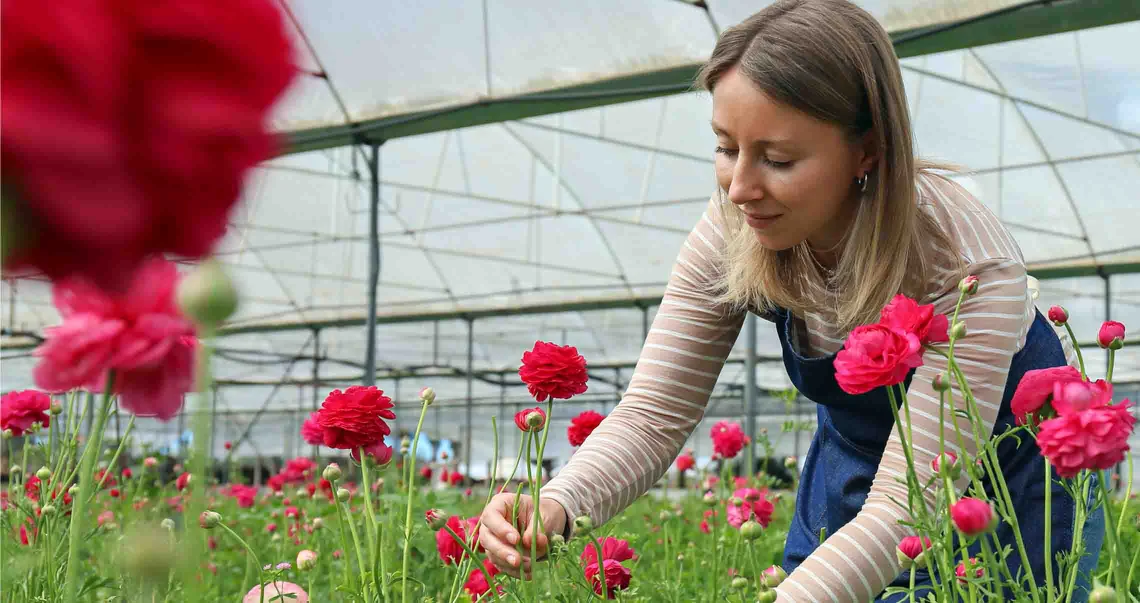Digital banking for business
Seamlessly access all of your accounts from one place with First Citizens Digital Banking for business.

Invest how you want, when you want, in real time with Self-Directed Investing.

Seamlessly access all of your accounts from one place with First Citizens Digital Banking for business.
We're committed to serving companies as they expand and succeed. The proof is in our success stories.
2026 Market Outlook video: Available now
The Making Sense team reflects on 2025 and discusses key headwinds and tailwinds for 2026.
For cut flower growers, 2020 wasn't coming up roses. With most states limiting social gatherings to help reduce the spread of the coronavirus, many weddings and other events were canceled or postponed. As a result, demand for bouquets and arrangements dropped dramatically. Making matters worse, some grocery stores scaled back orders to focus on selling essential products instead.

With fewer outlets to pursue for a perishable product, the flower agriculture industry suffered losses. If you're a large or small flower wholesaler looking to increase profitability, you'll need to adjust to the new realities of the market.
Since retail foot traffic and large events have been sidelined or significantly reduced, direct-selling opportunities through e-commerce are critical. Instead of focusing on wholesale operations, you may want to shift to accommodate the retail and consumer market more directly. Fortunately, you can do this in a few ways.
One of the positive trends that floral businesses can leverage is consumers' increased focus on their homes. With widespread social distancing due to the pandemic, many consumers are looking for ways to perk up their space while staying at home. Some of the cut flowers consumers prefer include roses, pansies, tulips and lilies. While some lockdown guidelines are likely to remain in place through much of 2021, consider shifting a greater share of your flower crops to these crowd favorites this growing season to brighten up some homes.
You might even consider taking on a new crop altogether. Instead of cut flowers, for example, you could sell garden plants. According to Nursery Management, about 50% of homeowners spent more time gardening in 2020. They may be looking to find flowering plants and vegetables, especially from local farms.
Similar to popular meal kits, you could offer subscription plans, with weekly, biweekly or monthly deliveries. Another way flower growers can stay viable during the economic downturn is to offer opportunities for people to give back. Create ways people can gift bouquets to healthcare and other essential workers.
You could also consider opening up your farm to visitors for tours and events. As people continue to look for safe outdoor activities, agritainment could be an attractive option, giving you a chance to show off your operations and sell bouquets and cut flowers. Another idea is partnering with other fresh produce growers and setting up a drive-through farmer's market.
Increasing profitability in any economic climate requires being vigilant with spending. As you look for ways to increase income, audit your expenses to identify opportunities to eliminate unnecessary spending.
While you may need to reduce your marketing budget, there are plenty of free or low-cost ways to get your business some exposure. Some growers donated cut flowers to nursing homes and hospitals, receiving some publicity for their kindness. You can also engage with potential customers over social media. Any marketing activity you do should be tracked to measure its return on investment. If one activity isn't working, try something else.
Many businesses had to furlough or cut back on staff. If you were able to keep on members of your team, consider using a slower time to reassign and tackle projects you've had on the back burner. For example, your employees might be able to help you update your online presence or streamline operations. Investing time now could help you grow when routine business picks up again.
It's also important to have some type of backup funds to weather a decline in sales. Getting a line of credit or business loan in place can provide a sense of security in tough times. It can also help to explore and apply for any available federal COVID-19 relief packages.
Many businesses were hit by the pandemic. The key to survival is two-pronged: Rethink your business to find new ways of generating revenue, and focus on day-to-day operations to maximize your bottom line. Consider the process to be like planting seeds for the future.



This material is for informational purposes only and is not intended to be an offer, specific investment strategy, recommendation or solicitation to purchase or sell any security or insurance product, and should not be construed as legal, tax or accounting advice. Please consult with your legal or tax advisor regarding the particular facts and circumstances of your situation prior to making any financial decision. While we believe that the information presented is from reliable sources, we do not represent, warrant or guarantee that it is accurate or complete.
Third parties mentioned are not affiliated with First-Citizens Bank & Trust Company.
Links to third-party websites may have a privacy policy different from First Citizens Bank and may provide less security than this website. First Citizens Bank and its affiliates are not responsible for the products, services and content on any third-party website.

Treasury & Cash Management
Electronic Bill Presentment & Payment
Investment & Retirement Services
Community Association Banking
Equipment Financing & Leasing
Credit Cards
Merchant Services
Email Us
Please select the option that best matches your needs.
Customers with account-related questions who aren't enrolled in Digital Banking or who would prefer to talk with someone can call us directly.